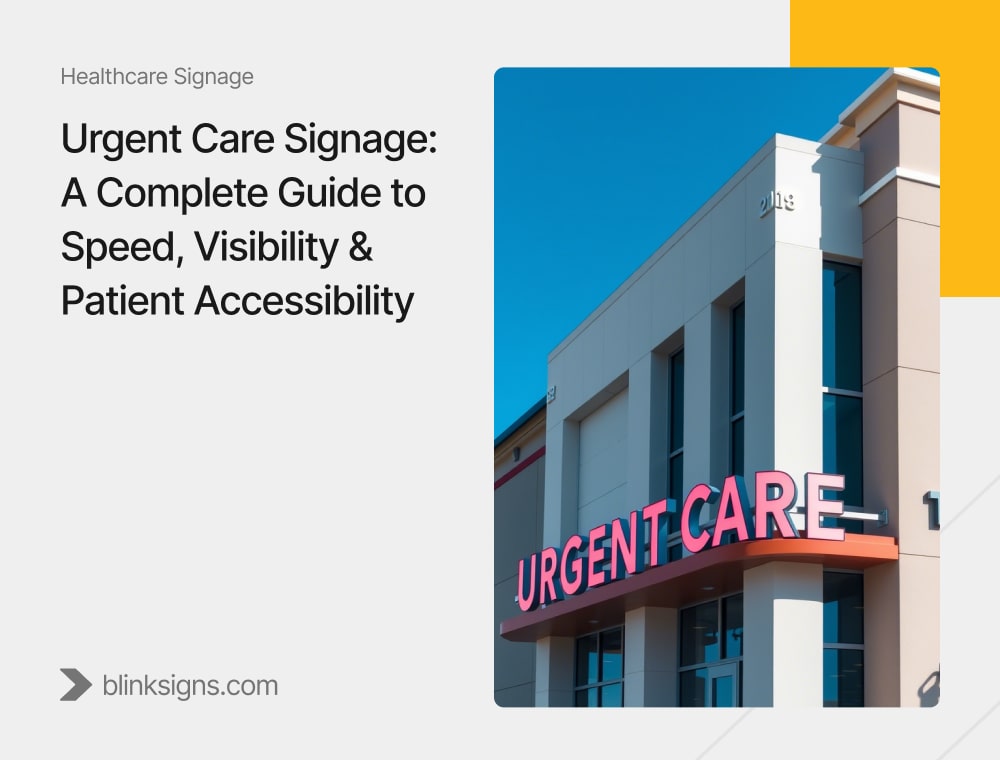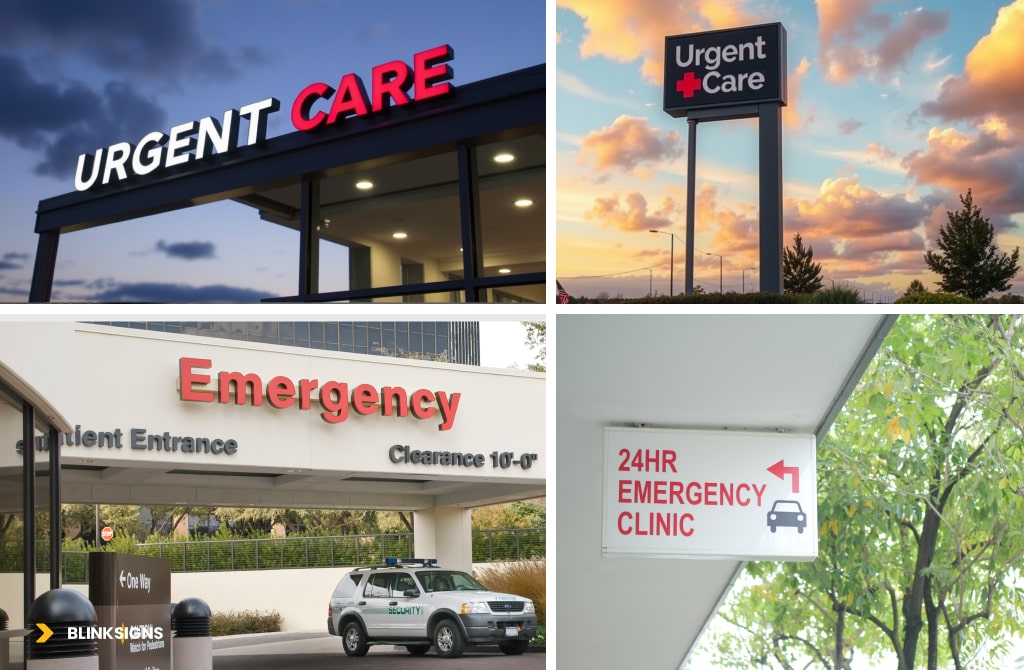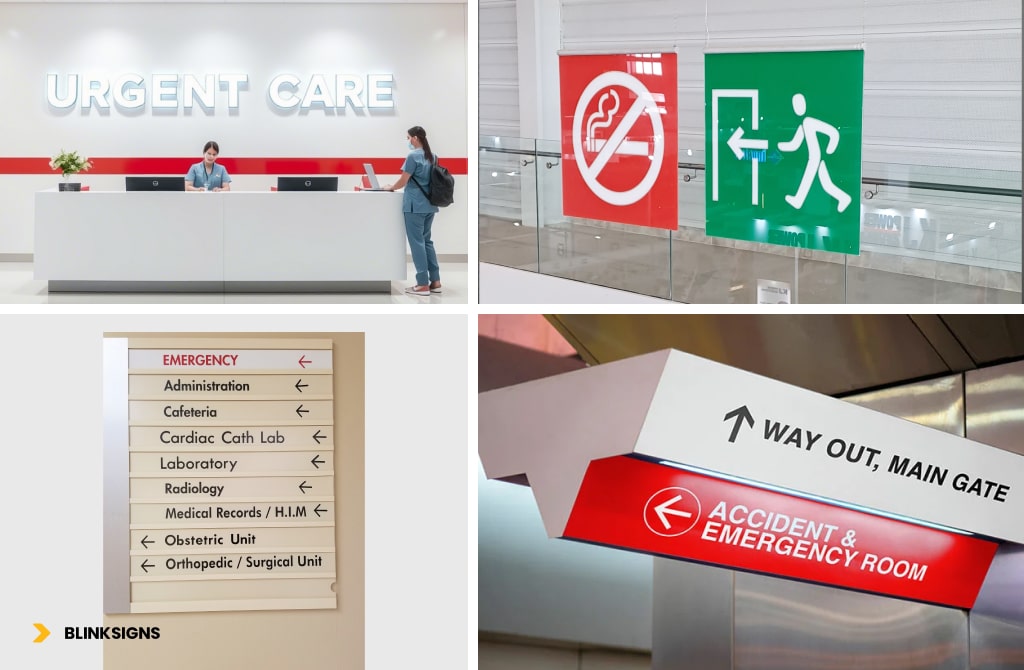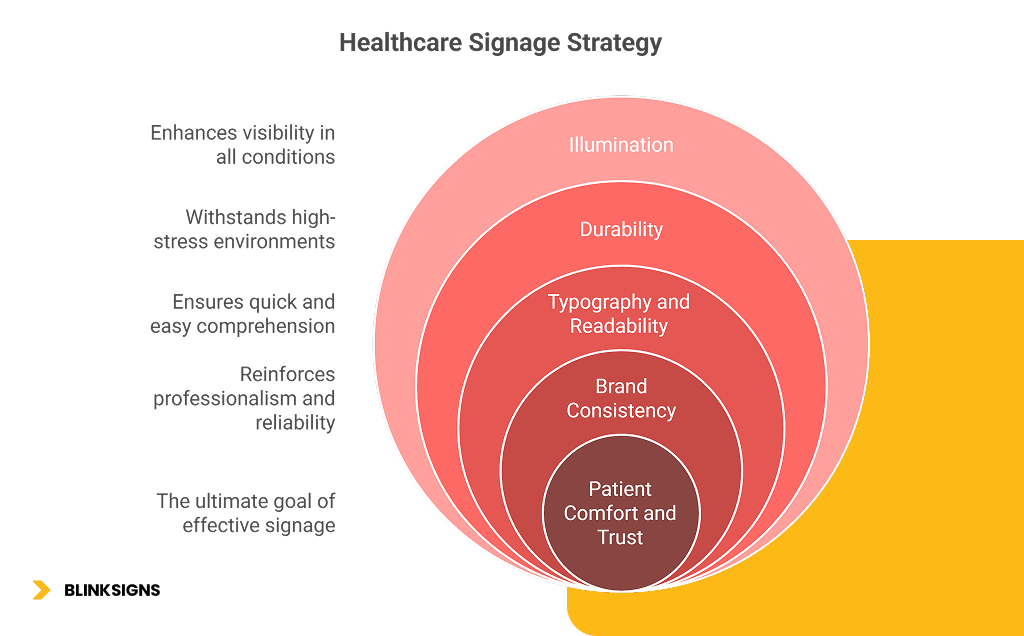
Urgent Care Signage: A Complete Guide to Speed, Visibility & Patient Accessibility
More Than a Sign, It’s the Start of the Patient Experience
In urgent care, time is not a luxury; it’s a lifeline. But for patients, the clock doesn’t start when they reach the front desk; it starts when they begin looking for your facility. In that moment, your signage becomes the first responder.
From a bustling roadside to the calm of a waiting room, signage guides, informs, and reassures. It’s not just a functional tool; it’s the start of the patient journey. For many, it sets the tone for how safe, cared for, and prioritized they feel. In healthcare, that first impression isn’t just important, it’s critical.
This guide explores how effective Urgent Care Center Signage enhances the Patient Experience (PX) through speed, visibility, and accessibility. It’s a strategic asset that blends design, psychology, and compliance, supporting everything from brand trust to operational efficiency.
Why Strategic Signage Is a Pillar of Modern Healthcare Operations
Too often, signage is seen as decoration or an afterthought. In a medical setting, however, it plays a foundational role in Patient Journey Mapping, the process of guiding individuals through your facility with confidence and clarity.
Reduces Patient Stress & Anxiety
When someone arrives at an urgent care facility, they’re already under stress, physically or emotionally. Clear and visible signage removes the fear of getting lost, misunderstood, or delayed. It helps create a sense of order in an otherwise uncertain moment.
Improves Operational Flow
Without proper signage, patients ask staff for directions, slowing down both intake and treatment. A well-designed Medical Facility Wayfinding System ensures that people get to the right place, lobby, restroom, or exam room—without asking. This keeps staff focused on patient care instead of hallway navigation.
Builds Instantaneous Credibility
Before a receptionist greets them or a nurse calls their name, your signage speaks volumes. High-quality, well-maintained Healthcare Signage conveys that your facility is professional, competent, and invested in patient well-being. It’s an extension of your care philosophy.
The Anatomy of High-Performing Urgent Care Signage
Exterior Signage — Winning the Race for Visibility and Speed

Exterior Urgent Care Signage
Before a patient reaches your doors, they need to find you quickly and clearly, often in a moment of urgency. This is where exterior signage becomes a strategic tool, not just a marker.
Key Signage Types & Their Roles:
| Sign Type | Primary Role |
| Pylon & Monument Signs | Provide roadside visibility, guiding patients from afar to your entrance. |
| Illuminated Channel Letters | Help identify your facility from the parking lot day and night. |
| Building Signs | Reinforce facility identity and ensure 24/7 visibility. |
| Parking & Directional Signs | Eliminate confusion with signs like “Patient Parking” or “After-Hours Entry.” |
| Digital Display Signs (EMCs) | Offer real-time updates like wait times, walk-in availability, and hours. |
These signs aren’t optional. They’re navigation tools, brand ambassadors, and information boards rolled into one.
While both Pylon and Monument Signs are foundational to urgent care visibility, each serves a different strategic purpose.
Pylon signs—often installed on tall poles—are ideal for roadside clinics on busy highways or multi-tenant complexes, offering long-distance visibility that cuts through clutter.
Monument signs, on the other hand, sit closer to the ground and communicate stability and prestige, making them well-suited for medical parks, suburban locations, or freestanding urgent care facilities.
Choosing the right one isn’t about preference—it’s about matching form to function based on visibility needs and zoning conditions.
Your Physical Sign is a Digital Beacon for Local SEO
Exterior signage isn’t just for drivers—it’s also for algorithms. Platforms like Google Business Profile (GBP) use real-world visuals from Google Street View, user-uploaded images, and local citations to validate your business location.
A professionally installed Pylon Sign or Channel Letter Sign that exactly matches your business name, hours, and services as listed on your GBP profile helps reinforce NAP (Name, Address, Phone) consistency—a key local SEO factor.
This physical-to-digital alignment improves trust signals, helping you rank higher in Google’s local map pack so patients can find you online before they ever step into the car.
Interior Wayfinding — Engineering Clarity, Calm, and Accessibility

Interior Wayfinding Signage for Urgent Care
Once inside, patients should never have to second-guess where to go. Interior signage must guide them from the lobby to the exam room without hesitation, stress, or delay.
The Foundation: Compliance and Inclusivity
In the U.S., interior signage is governed by strict ADA regulations, and for good reason. Inclusivity is not optional; it’s the law. But beyond legal compliance, it’s also a statement of your commitment to accessible care for all.
🔸 Legal Mandate: ADA-Compliant Signage
This includes:
- High-contrast color palettes for visibility
- Tactile elements like raised lettering
- Grade 2 Braille
- Placement guidelines for height, spacing, and location
🔸 Beyond the Basics: Building Trust Through Quality Materials and Smart Design
Serving diverse communities means going further—using multilingual signs, universal icons, and culturally sensitive design to communicate clearly to every visitor.
Core Components of the Interior Wayfinding System:
| Signage Element | Function |
| Lobby or Reception Sign | Sets tone, reinforces brand, and offers a clear welcome message |
| Overhead Directional Signs | Helps patients navigate larger spaces like hallways or waiting areas |
| Wall-Mounted Room Signs | Identifies rooms like labs, restrooms, offices, or exam areas |
| Privacy-Aware Signage | Strategically placed to avoid disclosing patient names near waiting areas, ensuring HIPAA compliance |
The Details That Define Quality and Build Trust
Interior signage carries more emotional weight than many realize. A well-crafted Lobby or Reception Sign is often the first thing a patient sees after walking through the door—it can immediately convey a sense of calm, care, and organization.
Directional signs mounted at consistent sight lines remove uncertainty from the navigation experience, especially for first-time visitors.
Room identification signs and icons should be universally understood, multilingual when possible, and located with privacy in mind. The goal isn’t just to inform—it’s to comfort, guide, and reassure, reinforcing your brand promise at every turn.
🔹 Brand Consistency Is Not Cosmetic—It’s Psychological
Every color, font, and logo sends a cue. When signage lacks uniformity, it creates cognitive friction for the visitor. A consistent visual identity reassures them that your facility is professionally run and trustworthy. BlinkSigns helps healthcare providers maintain brand compliance across multiple locations, a vital asset for growing urgent care chains.
🔹 Typography & Readability Matter More in Healthcare
Medical signage needs to be immediately legible from the correct distance. That means:
- Using sans-serif fonts like Helvetica or Frutiger
- Avoiding decorative styles that slow comprehension
- Applying proper spacing and font sizes for hallway, door, and overhead views
Accessibility isn’t just legal—it’s a lifesaving function when people need information quickly.
🔹 Durability: Built for High-Traffic, High-Stress Environments
Urgent care signage needs to hold up against more than time—it must withstand:
- Frequent cleaning with hospital-grade disinfectants
- Outdoor exposure to sun, rain, or snow
- Heavy foot traffic and possible physical contact
That’s why BlinkSigns uses materials that are weather-resistant, easy to sanitize, and fade-resistant, helping you avoid early replacements and compliance failures.
🔹 Illumination: Face-lit vs. Halo-lit Channel Letters
Lighting isn’t just aesthetic—it’s functional. A well-lit exterior sign ensures patients can find you at 8 PM in winter as easily as at noon in summer.
- Face-lit channel letters offer bright, direct visibility for fast identification
- Backlit or halo-lit letters provide a softer, upscale glow, ideal for suburban or premium locations

Urgent Care signage strategy – BlinkSigns
BlinkSigns helps facilities choose lighting based on location, patient demographics, and zoning requirements.
The BlinkSigns Advantage: A Turnkey Signage Partner for Healthcare
Signage for urgent care isn’t just about printing and hanging signs—it’s a multi-step, highly regulated process involving compliance, design, fabrication, and installation. Most healthcare providers don’t have time to navigate it all. That’s where BlinkSigns steps in.
We offer an end-to-end signage solution—customized, compliant, and controlled in-house.
Our Process: From Site Survey to Long-Term Success
| Stage | What We Do |
| Consultation & Site Survey | Evaluate your space, traffic patterns, branding, and local regulations |
| Custom Design & Permitting | Create ADA-compliant, visually aligned signs and handle permitting entirely |
| In-House Manufacturing | Control quality and timelines with on-site production using durable materials |
| Nationwide Installation | Deploy certified teams across the U.S. for consistent, safe sign placement |
| Maintenance & Repair Plans | Ensure longevity with regular inspections and repairs as needed |
Whether you’re opening your first location or managing dozens across the country, we standardize quality and scale your signage effortlessly.
Conclusion: Your Signage Is Your First Point of Patient Care
Signage isn’t just about direction—it’s about emotion, trust, and care. Every sign you install is a message: “You’re in the right place. We’re ready to help you.”
In a competitive healthcare landscape, investing in high-performance urgent care signage means investing in patient experience, operational clarity, and brand strength.
Check out our healthcare signage portfolio →
FAQs
What type of signage does an urgent care center need?
Urgent care centers require a combination of exterior signage—like pylon signs, monument signs, and channel letters—to attract attention and establish location visibility, and interior signage, such as ADA-compliant wayfinding, room identification, and reception signs, to guide patients through the facility.
BlinkSigns offers end-to-end signage systems tailored for medical environments, ensuring every sign meets both branding and compliance standards. Whether you’re launching a new clinic or standardizing signage across locations, we help you get it right from the start.
Why is ADA-compliant signage important in healthcare facilities?
ADA-compliant signage is a legal requirement and a critical component of accessible patient care. It includes high-contrast text, tactile lettering, Braille, and correct placement, ensuring that every patient, regardless of ability, can navigate your facility safely and confidently.
BlinkSigns specializes in ADA signage for healthcare. We handle design, fabrication, and installation in full compliance with federal and state accessibility standards, helping urgent care providers avoid costly penalties while serving their communities with dignity.
Can signage really improve patient satisfaction in urgent care?
Yes—clear, well-designed signage has a direct impact on the patient experience. When patients can easily find the entrance, check-in area, or exam rooms without asking for help, it reduces stress, builds trust, and enhances the perception of care even before they speak to a provider.
BlinkSigns helps urgent care centers design signage that improves patient flow, reduces anxiety, and supports your brand promise of fast, reliable care.
How does physical signage impact our local SEO and online visibility?
Your physical signage works hand-in-hand with your Google Business Profile and local SEO strategy. When your facility name, colors, and signage align with your online presence, it strengthens trust signals for Google Maps and helps validate your location via Street View and user photos.
BlinkSigns designs signage that aligns with your digital footprint, reinforcing NAP consistency (Name, Address, Phone) and boosting your visibility in local map packs—so patients can find you both online and on the street.
What’s the difference between pylons and monument signs for urgent care?
Pylon signs are tall and visible from a distance, ideal for high-traffic roads and busy intersections. Monument signs, on the other hand, sit closer to the ground and provide a premium, approachable feel—often preferred for medical parks or suburban clinics.
BlinkSigns can help you choose the right sign type based on your location, zoning restrictions, and patient demographics, ensuring optimal visibility and professionalism.
Does BlinkSigns handle permitting and installation for medical signage?
Yes—BlinkSigns offers complete signage project management, including site surveys, permitting, zoning compliance, and nationwide installation. Our team understands the complexities of medical regulations and local codes, helping you stay compliant and avoid costly delays.
From permit paperwork to certified installers, we manage everything so your staff can focus on patient care, not signage logistics.
How can we ensure consistent signage across all of our urgent care locations?
Consistency is critical for multi-location urgent care brands. BlinkSigns offers National Signage Programs that standardize your signage design, materials, lighting, and branding across every location.
We help healthcare groups maintain brand cohesion, streamline rollouts, and manage updates through a centralized signage strategy—saving you time, money, and rework.
What kind of materials and lighting are best for urgent care signage?
Urgent care signage needs to withstand harsh cleaning agents, weather, and heavy traffic. At BlinkSigns, we use hospital-grade, easy-to-sanitize materials and long-lasting illumination options like face-lit or halo-lit channel letters to ensure readability and longevity, day or night.
We guide you in selecting the right materials and lighting based on your location’s needs and local requirements.
Ready to Improve Your Patient Journey?
Contact the healthcare signage experts at BlinkSigns for a free consultation and site analysis. We’re here to help you design a signage system that’s fast, visible, compliant, and trusted.